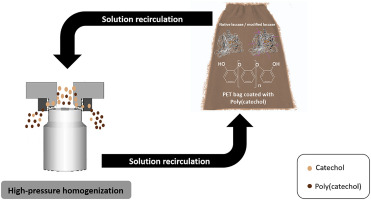Journal of Cleaner Production ( IF 9.7 ) Pub Date : 2018-08-21 , DOI: 10.1016/j.jclepro.2018.08.205 Jing Su , Jennifer Noro , Jiajia Fu , Qiang Wang , Carla Silva , Artur Cavaco-Paulo

|
Laccase from Myceliophthora thermophila was used to catalyze the polymerization of catechol under high-pressure homogenization for the green coloration of textile substrates. The oxidation reactions were conducted using different forms of laccase, namely native laccase, PEGylated laccase and PEGylated laccase immobilized onto an epoxy resin. The three enzyme forms were deposited inside a polyester fabric bag during the experiments. The amount of polymer obtained was similar when using the three enzyme forms and its dispersion in water/DMSO mixture lead to powder particles of about 30–60 nm. The immobilized and PEGylated enzymes lead to poly(catechol) with 13 and 10 units, respectively, while the native form gave rise to shorter polymers (DP = 8). We have shown that the oxidation of catechol conducted under high-pressure homogenization can be an efficient methodology for the in situ coloration of textiles. The polymers produced by this methodology stained strongly the textile container, revealing this experimental set-up as a promising greener coloration/coating methodology involving milder conditions than the normally used in textile processes.
中文翻译:

高压均质下邻苯二酚的酶促聚合,使纺织品呈绿色
嗜热毁丝霉的漆酶在高压均质作用下,用于催化邻苯二酚的聚合反应,使纺织品基质呈绿色。使用不同形式的漆酶,即固定在环氧树脂上的天然漆酶,PEG化漆酶和PEG化漆酶进行氧化反应。在实验期间,三种酶形式沉积在聚酯织物袋内。当使用三种酶形式时,获得的聚合物量相似,并且其在水/ DMSO混合物中的分散导致粉末颗粒约为30–60 nm。固定化酶和聚乙二醇化酶分别生成具有13和10个单元的聚(儿茶酚),而天然形式则产生了较短的聚合物(DP = 8)。我们已经表明,在高压均质化下进行的邻苯二酚氧化可以成为一种有效的方法。纺织品的原地着色。用这种方法生产的聚合物严重污染了纺织品容器,表明该实验装置是一种有前途的绿色着色/涂覆方法,涉及比纺织过程中通常使用的条件温和的条件。











































 京公网安备 11010802027423号
京公网安备 11010802027423号